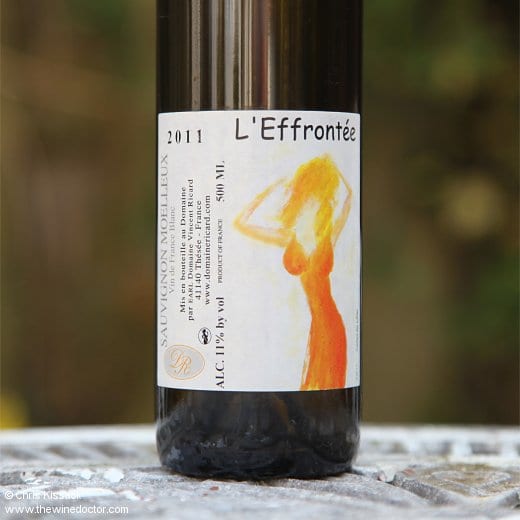Domaine Ricard L’Effrontée 2011
The marriage between variety and residual sugar, with or without the complicating features that come from botrytis, is a complex one. As an extreme example of a combination that didn’t work, I submit as evidence an experimental sweet Cabernet Franc from Anjou I tasted with its creator, a famed (and since retired) vigneron from the Loire Valley, more than a few years ago. He had made it after botrytis had taken hold in a vineyard of Cabernet Franc. Rather than discarding the fruit afflicted by rot and seeking out what could be salvaged, he instead embraced it, as one might have done if it were a field of nobly rotten Chenin Blanc. The wine, with its curiously faded, red-grey-brown hue (botrytis seems to strip the pigments from red grapes and the resulting wine), and its funky aromas and flavours, fell rather sort of what anyone with a half-functioning palate would want to drink. The Ligérian winemaker, I am glad to say, felt the same, and did not see fit to repeat the experiment.
In fact red varieties work well with residual sugar (any glass of Recioto, Maury, Banyuls or Port would tell you that, of course), it was botrytis that was the problem. Many (or should that be most?) of the world’s sweeter styles are based on botrytis though, in part at least, and so we should not be surprised that in the world of sweet wine, white varieties rule. What is perhaps more surprising, though, is that just a handful of varieties dominate the scene. In Alsace and the vineyards of Germany, there is Riesling, in the Loire Valley we have Chenin Blanc, and in Bordeaux there is Semillon. There are many others of course, Gewurztraminer, Pinot Gris, Malvoisie, Muscat, various Austrian varieties and so on. But the first three varieties undoubtedly rule the roost.

Having said that, despite the region’s great success with Chenin Blanc in the moelleux style, many Loire Valley vignerons are ready to try their hand with other varieties. This includes Sauvignon Blanc, a variety that plays a supporting role in Sauternes, Barsac, Cérons, Cadillac, Saussignac and the other sweet wines of Bordeaux and South-West France, but which is occasionally to allowed to shine alone. L’Extravagant de Doisy-Daëne in Barsac, the cuvée created by the Dubourdieu family in the 1990 vintage, is perhaps the most iconic example. Another fine but less commonly encountered example is Cuvée Paul, the late-harvest Sancerre from the Cotat family. There are others, but they come along with only slightly greater frequency than a Goutte d’Or cuvée in Vouvray. In other words, not very often.
To this very short shortlist we can one further example. Vincent Ricard is no stranger to breaking the rules when it comes to Sauvignon Blanc; he is the vigneron behind Vinsans Ricard, the sparkling Sauvignon Blanc I have featured twice before in recent years, in the 2016 and 2014 vintages. This time he has done something a little different; in 2011, that superb vintage which also saw Philippe Foreau produce the aforementioned Goutte d’Or cuvée (in only the third-ever vintage, after 1947 and 1990), Vincent left a portion of his harvest on the vine to dehydrate and concentrate. And presumably to pick up a touch of botrytis. He and his team eventually picked the fruit one evening in November, at a yield of just 9 hl/ha, and with a potential alcohol of 24%, a figure which any self-respecting vigneron working in the Coteaux du Layon or Coteaux de l’Aubance appellations would be more than happy with.
The 2011 L’Effrontée from Vincent Ricard has an imposing, burnished, orange-golden hue in the glass. This intense hue is matched by the complex concentration on the nose, which suggests a multifaceted sweetness. There are scents of orange blossom here, apricot and coconut, vanilla flower, lychee and raspberry, all coated with a thin veil of oxidation which brings to mind memories of warm hay, wild flowers and perfumed cloves. There follows a very confident and creamed palate, intensely viscous and sweet, and certainly more liquoreux than moelleux in terms of texture, with richly botrytised caramel and vanilla nuances. It has 11% alcohol, which means (looking at the potential alcohol) the residual sugar is probably well over 200 g/l, and the wine’s texture is certainly in keeping with that. It has a fresh acidity, although it struggles to cope with the wine’s intense concentration. All the same, there is no denying its impressive, sweet and peppery energy. It is an intriguing wine of some quality, and while I remain fascinated by Ligérian experiments making moelleux wines with Sauvignon Blanc, not to mention Melon de Bourgogne, Romorantin, Malvoisie and a host of other (all white) varieties, I don’t think those vignerons working with Chenin Blanc need lose any sleep. Not just yet, anyway. 92/100 (15/4/19)
Read more in:
- My guide to Sauvignon Blanc
- My previous report on the 2016 Vinsans Ricard
- My reports on the 2011 Loire Valley vintage
